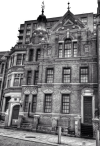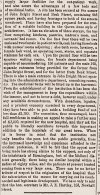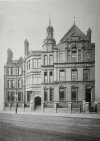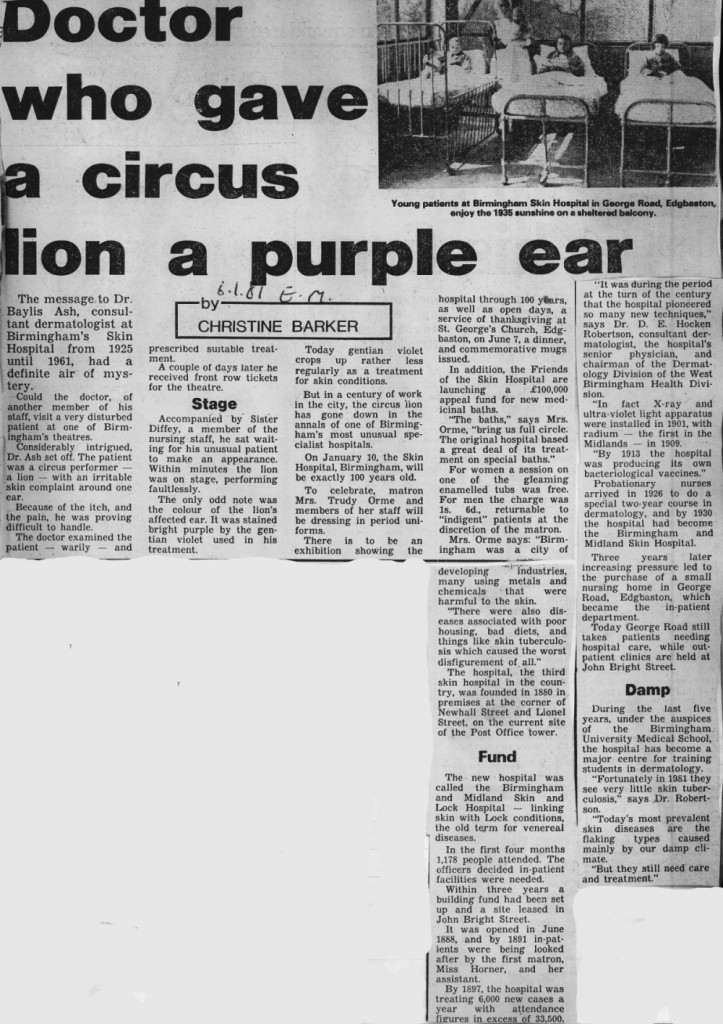As a "nipper" of four or five at begining of war I was admitted to Skin and Lock hopital with impetetigo.Due to threat of air raids at the time, it was policy not to admit children under the age of ten to hospitals if it could be avoided,but I was that bad there was no alternative.I remember on being admitted,stood in an empty bath and two nurses scrubbing at the impetigo with brushes and liquid from a basin,most likely permanganate of potash.I was then painted from head to foot with gentian violet and kept painted with it for the next month.Was told I was called "the little blue boy".During the day corrugated cardboard was wrapped and tied round my arms so I couldn't bend them at the elbow to scratch and at night my wrists were tied to sides of cot for same reason.The worst memory I've got of the place though is of being made to eat fish covered with parsley sauce.I'm not keen on fish and I hate parsley sauce.
-
Welcome to this forum . We are a worldwide group with a common interest in Birmingham and its history. While here, please follow a few simple rules. We ask that you respect other members, thank those who have helped you and please keep your contributions on-topic with the thread.
We do hope you enjoy your visit. BHF Admin Team
You are using an out of date browser. It may not display this or other websites correctly.
You should upgrade or use an alternative browser.
You should upgrade or use an alternative browser.
L
LindaJune
Guest
When I was about 4 years old I had a skin problem that I understand was caused by some bug in the sand pit at the nursery on Kingstanding Road. I can remember my face being bandaged with holes left for my eyes, nose and mouth. The bandages would stick and I would only allow one of my older sisters to soak and loosen them. When I had appointments at the Skin Hospital, John Bright Street people on the bus would not sit near me. I remember my mom taking me to the Hospital, I must have known that I was going to be admitted because, as my mom went up the steps and rang the bell, I ran away, around a corner that was a car showroom. Once admitted I had my hair shaved off and was bathed in gentian violet. I was in a closed ward and visitors could only look through the ward doors. My sister was so scared she fainted. I still shudder at the memory of being tied by bandages to the cot sides at nap time and the nurses forgetting to undo them for visiting time and the frustration of trying to sit up to see my mom through the doors. I'm the sad little soul front left on the photo. You can just see the Christmas tree in the background. Didn't we look a sorry sight? I wonder if anyone out there can see themselves?
G
Glenys
Guest
My mother was a nurse at the Birmingham skin hospital in the early 1930's. She left an uncles farm in deepest Devon where she had been sent as an orphan in 1929. When she was 17 she answered an ad. in the paper for nurses. A real culture shock for her. She had never heard or venerial diseases and the nurses came and went so fast she quickly became head probationer. Her best friend was a Welsh girl who I was named for many years after. Glenys!
G G Jean
Brummy Wench.
Linda could you imagine what would happen if they did that to a child these days I am sure I would have hidden anywhere to avoid that treatment. I remember someone in my class at school [won't name them] who always had impatigo [I think that is how you spell it] and his face was painted with that purple stuff. It was an advert not to go near incase you catch it. Glenys I bet it was a culture shock for your mom. My mom had to go to the hospital a couple of times when she was suddenly covered from head to toe in a very itchy rash. They found out it was a reaction from a beta blocker drug that would flair up from time to time. She used to bath in Alfa Keri oil and I use that now and again as it makes your skin feel soft afterward and is theraputic. Jean.
M
Mossy
Guest
This is the only mention of this hospital i can find
Orthopaedic, the Hospital for Women's Diseases, the Skin and Lock Hospital, the Homoeopathic Hospital, a dental hospital, a lying-in charity, a city hospital for cases of infectious disease, and a large infirmary belonging to the parish of Birmingham. There is also a general dispensary, the officers of which visit patients at their own homes. The Sanatorium is at Black-well, on the slopes of the Lickey Hills. There are also training
This is the site i found it on very interesting site good reading
https://uk-genealogy.org.uk/england/Warwickshire/places/Birmingham.html
Mau-reece
Orthopaedic, the Hospital for Women's Diseases, the Skin and Lock Hospital, the Homoeopathic Hospital, a dental hospital, a lying-in charity, a city hospital for cases of infectious disease, and a large infirmary belonging to the parish of Birmingham. There is also a general dispensary, the officers of which visit patients at their own homes. The Sanatorium is at Black-well, on the slopes of the Lickey Hills. There are also training
This is the site i found it on very interesting site good reading
https://uk-genealogy.org.uk/england/Warwickshire/places/Birmingham.html
Mau-reece
Last edited by a moderator:
ColinB
gone but not forgotten
Mike, thats the article I got most of my information from for my website.
https://www.bhamb14.co.uk/index_files/BIRMINGHAMSKINHOSPITAL.htm
Colin
https://www.bhamb14.co.uk/index_files/BIRMINGHAMSKINHOSPITAL.htm
Colin
E
Elizabeth Redmond
Guest
Those little hospitals are not there now are they? The eye hospital,Ear nose and throat,Impetigo not sure if that is spelt correctly i'm sure these days they would just give antibiotic's,thank god people are not treated like that anymore
Old Boy
master brummie
Those little hospitals are not there now are they? The eye hospital,Ear nose and throat,I
Hi Elizabeth.
The Eye Hospital is now in Western Road on the site of the old infirmary and adjacent to City Hospital. It is called The Birmingham and Midland Eye Centre and, according to a notice in the Outpatients Dept, it is the second largest in Europe.
Old Boy
E
Elizabeth Redmond
Guest
Oh yes i remember i had to go there a few years ago, what we used to know as Dudley Rd
cearnegiant
master brummie
I remember the Skin Hospital that I think was down by Alexandra theatre.Went there few times in early 1970s to take people home from outpatients dept.One of my relatives was patient there probably in the 1940s ,He always refered to it as the Skin and Lock hospital.Would think the Lock refered to Hair?Would the location be John Bright Street??
ColinB
gone but not forgotten
The Birmingham Skin and Lock Hospital was in John Bright Street and now located at City Hospital. It was for the treatment of Skin and Urinary diseases dealing with skin complaints such as psoriasis and dermatitis and venereal disease, some more information on my website https://www.bhamb14.co.uk/index_files/BIRMINGHAMSKINHOSPITAL.htm and on this forum https://forum.birminghamhistory.co.uk/showthread.php?t=12406
Colin
Colin
cearnegiant
master brummie
Thanks for that,I know my uncle treated there for problem he has with scalp.I know lost some of his hair,Thats why thought The Lock in title refered to Hair,
Anthony Collins
proper brummie kid
Does anyone know which building firms worked on hospital please?
Thanks Anthony Collins
Thanks Anthony Collins
A Sparks
master brummie
Does anyone know what's happening with the old Skin Hospital building in John Bright Street?
I can only find that it was up for sale in 2017 and it appeared it had been bought with the intention of turning it into a night club - did that happen?
I've just looked at it on Google street view, obviously it won't be open at the moment with Covid, but it looks a bit sad - tagging graffiti on the walls and windows.
Very sad, it's a lovely building.
I can only find that it was up for sale in 2017 and it appeared it had been bought with the intention of turning it into a night club - did that happen?
I've just looked at it on Google street view, obviously it won't be open at the moment with Covid, but it looks a bit sad - tagging graffiti on the walls and windows.
Very sad, it's a lovely building.
mw0njm.
A Brummie Dude
Skin Hospital, John Bright Street

this listed building on John Bright Street is a former hospital, built in 1881, it opened in 1888. It was originally Birmingham Skin and Urinary Hospital but I’ve heard it described as the Birmingham Skin and Lock Hospital and I wondered what that meant. After a little research it seems that Lock Hospitals were for the treatment of people with venereal diseases. The hospital had three entrances, one for staff, one for men and one for women and children. In 1935 the main skin hospital moved to new premises but the John Bright Street building remained open as an outpatients department until 1983.
Janet Hunt
master brummie
The original Lock Hospitals were as described for treating venereal diseases. However, they were much more than this and certainly not pleasant places for their patients, they were predominantly for treating women with venereal diseases.
Have just read an article about one in Glasgow, based on Rottenrow is described as akin to an internment camp. The origin of the name is from English "Loke" meaning home for lepers. Many of these women were fallen women working as prostitutes locally. But many were children of school age upwards.
It is believe a lot of these children were from Glasgows, Magdalene Asylum for fallen women. In one year around a dozen children were transferred from the asylum to the lock. A vile belief at this time was that men could cure themselves from venereal diseases by having intercourse with a young virgin.
Patients were kept in isolation with no contact. Treatment included the use of Mercury, which we all know is a poison. Many never had chance to return to normal life as they were seen as contaminated those that did returned to prostitution. Victorian cases of child abuse were rarely discussed and often just swept under the carpet. The Lock hospital in Rottenrow only closed for good in 1947. Many of the horrors that took place we will never know. I can imagine that the one in Birmingham had a similar horror story to tell.
Have just read an article about one in Glasgow, based on Rottenrow is described as akin to an internment camp. The origin of the name is from English "Loke" meaning home for lepers. Many of these women were fallen women working as prostitutes locally. But many were children of school age upwards.
It is believe a lot of these children were from Glasgows, Magdalene Asylum for fallen women. In one year around a dozen children were transferred from the asylum to the lock. A vile belief at this time was that men could cure themselves from venereal diseases by having intercourse with a young virgin.
Patients were kept in isolation with no contact. Treatment included the use of Mercury, which we all know is a poison. Many never had chance to return to normal life as they were seen as contaminated those that did returned to prostitution. Victorian cases of child abuse were rarely discussed and often just swept under the carpet. The Lock hospital in Rottenrow only closed for good in 1947. Many of the horrors that took place we will never know. I can imagine that the one in Birmingham had a similar horror story to tell.
Thanks for a super explanation. One night with Venus, the rest of your life with Mercury as they say about the treatment before antibiotics.The original Lock Hospitals were as described for treating venereal diseases. However, they were much more than this and certainly not pleasant places for their patients, they were predominantly for treating women with venereal diseases.
Have just read an article about one in Glasgow, based on Rottenrow is described as akin to an internment camp. The origin of the name is from English "Loke" meaning home for lepers. Many of these women were fallen women working as prostitutes locally. But many were children of school age upwards.
It is believe a lot of these children were from Glasgows, Magdalene Asylum for fallen women. In one year around a dozen children were transferred from the asylum to the lock. A vile belief at this time was that men could cure themselves from venereal diseases by having intercourse with a young virgin.
Patients were kept in isolation with no contact. Treatment included the use of Mercury, which we all know is a poison. Many never had chance to return to normal life as they were seen as contaminated those that did returned to prostitution. Victorian cases of child abuse were rarely discussed and often just swept under the carpet. The Lock hospital in Rottenrow only closed for good in 1947. Many of the horrors that took place we will never know. I can imagine that the one in Birmingham had a similar horror story to tell.
Pedrocut
Master Barmmie
Skin Hospital, John Bright Street
View attachment 175911
this listed building on John Bright Street is a former hospital, built in 1881, it opened in 1888. It was originally Birmingham Skin and Urinary Hospital but I’ve heard it described as the Birmingham Skin and Lock Hospital and I wondered what that meant. After a little research it seems that Lock Hospitals were for the treatment of people with venereal diseases. The hospital had three entrances, one for staff, one for men and one for women and children. In 1935 the main skin hospital moved to new premises but the John Bright Street building remained open as an outpatients department until 1983.
The Skin and Lock was at temporary place at 103 Newhall Street in 1881.
May 1886, Birmingham Daily Post, gives the details of the future move to John Bright Street.


Pedrocut
Master Barmmie
The Skin and Lock Hospital came into existence in 1881 and was referred to as such until the early 1920s. It then became the Skin and Urinary Hospital for a short time until it became just the Skin Hospital in the mid 1920's.
For anyone interested the are a few annual reports for the hospital in the early 1940s on the Internet Archive.
For anyone interested the are a few annual reports for the hospital in the early 1940s on the Internet Archive.
Janet Hunt
master brummie
Just found this article dated 1882 on Lock Hospitals..page 22 states Birmingham did not have one. Guess this was because it opened after that date. Interesting read.
Lock Hospitals - Forgotten Books
Pedrocut
Master Barmmie
Skin Hospital, John Bright Street
View attachment 175911
this listed building on John Bright Street is a former hospital, built in 1881, it opened in 1888. It was originally Birmingham Skin and Urinary Hospital but I’ve heard it described as the Birmingham Skin and Lock Hospital and I wondered what that meant. After a little research it seems that Lock Hospitals were for the treatment of people with venereal diseases. The hospital had three entrances, one for staff, one for men and one for women and children. In 1935 the main skin hospital moved to new premises but the John Bright Street building remained open as an outpatients department until 1983.
Another wider view of the Skin and Lock Hospital, John Bright Street (1886)
Health care in Birmingham : the Birmingham teaching hospitals 1779-1939 by Reinarz, Jonathan. (2009)

brummy-lad
master brummie
Now for sale with planning consent to develop the site into 15 luxury apartments.

 www.birminghammail.co.uk
www.birminghammail.co.uk

Former 'iconic' city centre building with permission for luxury flats for sale
The Birmingham Skin Hospital, located at 71-79 John Bright Street, is listed with a sale price of £1.5m
I may be getting a little mixed up, wasn't part of this building turned into a Pub late 80s or early 90s, possibly 'Rosie O'Briens', or was that another old building on John Bright St. ?I expect the developer will make a big thing about its history . Or will they ?
A Sparks
master brummie
I think that was probably another building.I may be getting a little mixed up, wasn't part of this building turned into a Pub late 80s or early 90s, possibly 'Rosie O'Briens', or was that another old building on John Bright St. ?
I worked part time at the old Ikon Gallery in John Bright Street in the 90s and there were offices in the Skin Hospital building then, the Birmingham Royal Ballet originally had an office in there.

